Dividend-paying Defense Stocks Rise in Race for Space
By: Paul Dykewicz,

Dividend-paying defense stocks are rising amid the race for space as the United States seeks to retain a competitive advantage versus authoritarian governments such as Russia and China.
The dividend-paying defense stocks provide military equipment and surveillance that the United States can give to Ukraine as the latter country seeks to defend itself against a continuing invasion from Russian forces that began on Feb. 24. The same capabilities could be offered to Asia-Pacific countries that recently have been threatened by provocative statements and military overflights from China.
The market has rewarded dividend-paying defense stocks in 2022, as Russian’s ongoing attacks and occupation of Ukrainian territory show no signs of abating. Despite Russia violating international law by its invasion of Ukraine’s territory, the aggressor is continuing to meet stiff resistance, even as it leaves millions of civilians with no power, internet or water.
The vast majority have missiles, shells and drones have been shot down by Ukrainian forces, whether they are coming from Russia’s ships on the Black Sea or the positions it holds in the Crimea region of Ukraine. Multiple regions of Ukraine, including its capital, faced a massive Russian missile attack Thursday, Dec. 29, the biggest wave of strikes in weeks.
Dividend-paying Defense Stocks Rise in Race for Space
Russia’s strikes on power and water supplies appear intended to inflict increased suffering on the Ukrainian population. Those attacks have occurred almost weekly since October while Ukraine’s ground forces struggle to hold ground and advance.

Courtesy of www.StockRover.com. Learn about StockRover by clicking here.
Entrepreneurs Like Elon Musk Affect Dividend-paying Defense Stocks
The decision that Russia’s leaders announced on July 26 to leave the International Space Station (ISS) program after 2024 proved them to be unreliable partners as launch providers, creating an opening for Western companies. The U.S. commercial space industry is gaining momentum as a major provider not only of defense and launch capabilities, but in-orbit satellite services.
The invasion of Ukraine injected urgency into the space race, with Russia’s leaders subsequently opting to deny the United States access to Soviet-era Soyuz launchers. American launch service providers such as SpaceX, Blue Origin and Space Launch System (SLS) are seeking to take the business that Russia’s President Vladimir Putin chose to abandon.
Skousen Seeks Dividend-paying Defense Stocks
Mark Skousen, the head of the Forecasts & Strategies investment newsletter and a leader of the Fast Money Alert trading service that invests in both stocks and options, questioned SpaceX and Tesla (NASDAQ: TSLA) founder Elon Musk at the annual Baron Investment Conference held in New York on Nov. 4. Skousen, who also is a Chapman University Presidential Fellow and recently was named the first Doti-Spogli Chair in Free Enterprise at its Argyros School of Business and Economics, cautions to steer clear of Tesla due to the stock’s sky-high valuation, even though he has recommended it profitably in previous years. Tesla fell a shocking 66.34% in 2022.

Mark Skousen, a scion of Ben Franklin and head of Fast Money Alert, meets Paul Dykewicz.
When Skousen asked Musk about why investors should invest in non-dividend-paying Tesla at its much higher price-to-earnings (P/E) valuation rather than dividend-paying EV competitors, the entrepreneur told attendees at the Baron Funds Investment Conference in New York that he understood that point. Musk said has told the investing public in the past that Tesla shares were too high, “and they ignore me and buy the stock anyway.” SpaceX is not a public company yet, but its prowess as a launch and broadband satellites services provider could position it to go public in the future.

Paul Dykewicz meets with CEO Ron Baron at the end of the Baron Funds conference.
Jim Woods, a seasoned investment guru, also is the leader of the Bullseye Stock Trader advisory service that recommends stocks and options. Woods, who concurrently heads the Intelligence Report investment newsletter, is a former Army paratrooper who has strategically invested in defense stocks that are involved in the space industry. He recently recommended the stock and options in two traditional defense companies that also serve the space sector.

Paul Dykewicz meets with Jim Woods, head of Bullseye Stock Trader.
Democrats and Republicans clash on most issues these days but they have been united in the defense of America and freedom around the world by supporting increased funding toward aerospace programs to protect against threating actions by Russia, China, North Korea, Iran and others. Aerospace companies traditionally have withstood inflationary pressures, slow economic growth, rising interest rates and the uncertainty of election years such as this one, said Ron Epstein, the aerospace and defense analyst at BofA Global Research.
Skousen and Woods team up on the Fast Money Alert trading service, and they combined to produce a short-term gain of nearly 10% with their Oct. 3 recommendation of defense, space and cyber consulting firm Booz Allen Hamilton (NYSE: BAH), of McLean, Virginia. The call options they recommended zoomed 239.27% in just 28 days before they advised selling.
General Dynamics Is Among Dividend-paying Defense Stocks Rising in Race for Space
General Dynamics (NYSE: GD), a global aerospace and defense company based in Reston, Virginia, is a recommendation of BofA and stock picker Jim Woods in his monthly Intelligence Report investment newsletter. The company produces combat vehicles, nuclear-powered submarines and communications systems to provide safety and security.
The company’s defense program exposure to land and sea priorities, coupled with its Gulfstream business jet manufacturing segment, could spur near-term and medium-term organic growth. It also has a strong balance sheet and solid cash generation, aiding dividend growth and share repurchases, BofA added.
BofA set a price objective of $325 on General Dynamics, noting it faces risks. On the defense side of its business, the risks include possible poor execution on defense programs hurting margins and any U.S. Defense Department budget cutting medium- and long-term growth. General Dynamics rose 21.40% in 2022.
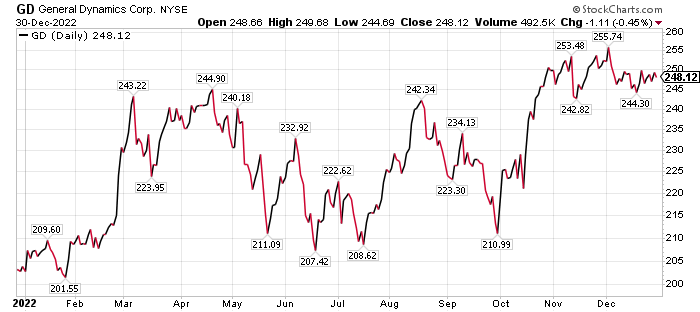
Chart courtesy of www.stockcharts.com
Raytheon Ranks With Top Dividend-paying Defense Stocks
Raytheon Technologies Corp. (NYSE: RTX), of Waltham, Massachusetts, is another buy recommendation of BofA. The multinational aerospace and defense conglomerate is one of the largest aerospace, intelligence services and defense manufacturing providers in the world, based on revenue and market capitalization.
BofA gave Raytheon a price target of $120, based partly on a blend of U.S. defense and global commercial aerospace growth. Risks to attaining that price objective are a potential downturn in commercial aviation due to the natural business cycle or an exogenous event such as a terrorist attack or a renewed pandemic threat. A severe global economic slowdown would affect top-line growth, since 45% of sales are generated outside the United States.
Execution risk on defense programs could result in cost overruns and margin contractions, BofA added. Orders from international programs are difficult to time due to the complexity of the process. Thus, lumpiness could occur with international orders. Another blow could come from unexpected cancellations to military or commercial programs.
Outperformance could come from commercial aerospace and business aviation jet recoveries or earnings beating projections, BofA wrote. If margins fare better than forecast, there could be upside potential to the investment firm’s valuation of Raytheon. If the company executes on existing programs better than expected, gains share in the international market or makes a materially accretive acquisition, there could be greater-than-anticipated upside in the shares, BofA wrote.
Despite the market falling overall in 2022, Raytheon rose 19.33% for the full year.
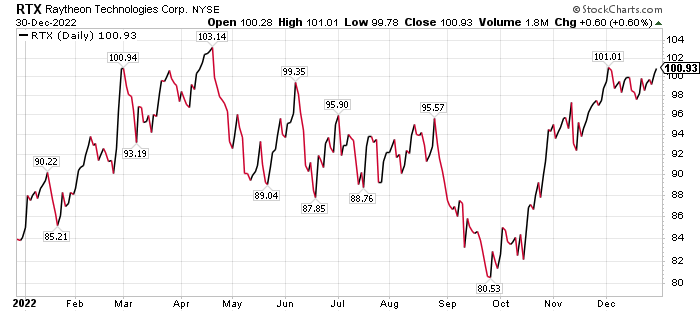
Chart courtesy of www.stockcharts.com
Northrop Grumman is Another of the Dividend-paying Defense Stocks
Northrop Grumman, a multinational aerospace and defense technology company headquartered in Falls Church, Virginia, teamed up with NASA in July to conduct a full-scale static fire of NASA’s Space Launch System (SLS) rocket motor, known as Flight Support Booster-2. The five-segment solid rocket booster is designed to have the world’s largest solid rocket motor to provide more than 75% of the SLS rocket’s initial thrust during launch.
In the test flight, more than 300 measurement channels assessed the 154-foot-long solid rocket booster as it fired for slightly more than two minutes to produce upwards of 3.6 million pounds of thrust. The test evaluated new materials and demonstrated an ignition system and an electronic thrust vector control system to steer the motors to provide data for the development of the next-generation Booster Obsolescence and Life Extension (BOLE).
Northrop Grumman won a contract to develop the BOLE booster in December 2021. The award included follow-on production and flight sets for Artemis IV through Artemis VIII, and a BOLE booster set for Artemis IX.
Michelle O’Connell, who leads Dallas-based Portia Capital Management, recommends Northrop Grumman. The company’s involvement in the growing space launch program only enhances its appeal, she told me. The market likes Raytheon, as well, as the stock rocketed 42.71% in 2022.

Michelle Connell leads Dallas-based Portia Capital Management.
Continuous product improvements and obsolescence mitigation help NASA achieve its long-term mission to use SLS for its Artemis program, said Wendy Williams, vice president, propulsion systems, Northrop Grumman. The test offers a chance for early learning on next-generation systems, she added.
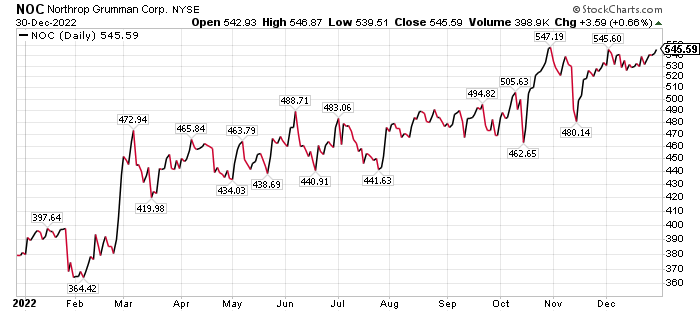
Chart courtesy of www.stockcharts.com
Reinvestments in R&D Strengthen Dividend-paying Defense Stocks
In 2021, the total space economy reached an estimated $469 billion, up 62.8% in 10 years from 2011 estimates of $288 billion, according to BofA Global Research. Approximately 79% of that total market value is attributed to commercial space products and services, the investment firm added.
Global government spending on space was estimated at $87.35 billion in the same time period, accounting for a sizeable 20% share of the market, according to Statista. In the United States, defense spending has been rising steadily for the last 15 years to the benefit of both publicly traded and privately held companies. However, the current free-market dynamics just became a feature of the space industry in recent years.
The emergence of digital technologies, such as advanced metal manufacturing and robotics, have cut production costs and sped up project completion, according to BofA. Furthermore, large investments in research and development (R&D) have allowed space companies to vertically integrate to try to gain increased control of their own supply chains, as opposed to minimal investments of 2-5% in research and development (R&D) annually by some defense prime contractors. Instead of spending their own earnings on R&D, large defense prime contractors often wait for DoD contracts to fund their projects.
“This sluggishness in development stands in stark contrast to the agility of space companies like Virgin Galactic and SpaceX,” BofA wrote in a recent research note. “For example, SpaceX produces 70% of Falcon launch vehicle components in its California production facility.”
Reports Show China’s COVID Cases Climb Sharply After Relaxing Zero-Tolerance Policy
The U.S. government will require mandatory negative tests starting Jan. 5 for all passengers seeking to enter the country from China, after the latter country reported a spike in COVID-19 cases. France and several other countries also mandated clean COVID-19 tests for passengers arriving from China, reflecting global concern that new variants could emerge in the ongoing outbreak.
There have been no confirmed reports of new variants to date, but China has been accused of a lack of transparency since the virus first surfaced in the country in late 2019. The worry is that China may not be sharing data about any evolving strains that could spark fresh outbreaks in other countries.
Along with the United States, Japan, India, South Korea, Taiwan and Italy have announced passengers from China would need to test negative for COVID. An internal meeting of China’s National Health Commission estimated that up to 248 million people contracted the coronavirus over the first 20 days of December, according to media reports. COVID-19 is slamming cities in China after its government recently chose to ease its strict anti-virus controls.
China’s leaders recently reconsidered their Zero-tolerance policy for COVID cases that had been in effect the last three years. Large protests in many of China’s cities last month may have convinced the nation’s leaders to modify the policy of strictly locking down communities where COVID outbreaks occurred.
China’s economy may gain a short-term boost from relaxing its COVID-19-related lockdowns, but a spike in cases and deaths could cause shutdowns to be ordered again by government leaders. Lockdowns cut the supply of goods and prevent many people from working, shopping and obtaining food and water without assistance. A real estate slump also could ensue.
U.S. COVID Cases Exceed 100.7 Million
COVID-19 cases in the United States totaled 100,771,854, up more than 30,000 in two days, and deaths reached 1,092,650, as of Dec. 30, according to Johns Hopkins University. Until last week’s news that estimated China had 248 million cases of COVID-19, America had the dreaded distinction of incurring the most coronavirus cases and deaths of any nation. Worldwide COVID-19 deaths soared to 6,689,274 people, up more than 6,500 in the past two days, while total cases hit 660,109,069, Johns Hopkins announced on Dec. 30.
The U.S. Centers for Disease Control and Prevention reported that 268,363,272 people, or 80.8% the U.S. population, have received at least one dose of a COVID-19 vaccine, as of Dec. 28. People who have completed the primary COVID-19 doses totaled 229,135,170 of the U.S. population, or 69%, according to the CDC. The United States also has given a bivalent COVID-19 booster to 44,711,483 people who are age 18 and up, equaling 17.3% as of Dec. 30, rising from 16.8% last week, up from 16.3% the prior week and jumping from 15.5% the week before that one.
Ukraine’s President Volodymyr Zelensky’s secret Dec. 21 flight to Washington, D.C., let him meet with U.S. President Joe Biden. Zelensky then addressed a joint session of Congress that evening. Zelensky’s surprise visit marked his first international trip since Russia’s invasion. The trip required Zelensky to travel by train to Poland, where he boarded a U.S. military aircraft to fly to America. He took the trip to rally support for additional funding for Ukraine’s defense from Russia’s unrelenting aggression.
Russia launched 16 so-called “kamikaze” drones into Ukraine under the cover of darkness early Friday morning, Dec. 30, a day after firing dozens of missiles at civilian targets, power plants and other critical infrastructure. They mark the latest attacks against Ukraine that have left roughly 10 million people there in darkness without heat or electricity amid frigid winter weather.
At least 76 missiles also were launched by Russia at major Ukrainian cities, including Kyiv, Odesa, Poltava, Zhytomyr, Kharkiv and Sumy, on Friday, Dec. 16, according to the Ukrainian Air Force. Russia is continuing its onslaught of intensified strikes that began in October, targeting Ukraine’s energy and civilian infrastructure.
Russia’s decision to sever its collaboration in space with the United States and other Western nations that have backed economic sanctions against the aggressor in its sustained attack on Ukraine have increased interest among U.S. defense stocks focused on space to pursue a heightened share of the U.S. government’s growing number of space exploration missions. The dividend-paying defense stocks serving the space sector are becoming key contractors in America’s renewed race for superiority in space.





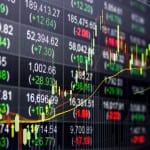
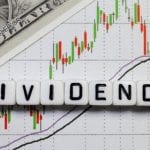
 Connect with Paul Dykewicz
Connect with Paul Dykewicz




